#born 29th october 1925
Text
(Old post)
Despicable Minions (DM AU) - Henry Wilde/Wild Knuckles info
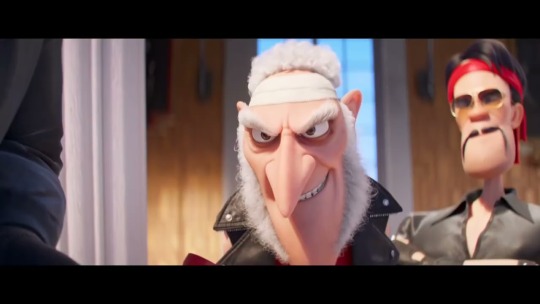
Henry Wilde was born on 29th May 1902 to Ronan Wilde and Beatrix Wilde (nee Maier) when they were in China.
His father belonged to an Irish villainous family - he himself was known under his alias "Knuckles";
His mother was a stay-at-home mother and a big support to young Henry;
Until 1912 Henry was learning martial art with his father - in 1912, the family moved to San Francisco;
When Henry was 13, his mother died and his father started neglecting his son - at the age of 18, Henry ran away and became a solo villain;
To show he's a better villain than his dad, he also chose an alias "Wild Knuckles" - he did it to show even his pseudonym represents who's better there;
Two years after Henry's escape, his father was killed during an argument with a different villain;
Some years passed and Wild Knuckles became one of the dreadest villains in history - during these years, he also received a status of a supervillain;
In 1925, Henry met Nora Berne, the only daughter of a café manager (Nora's father was actually a villain and one of Henry's idols when he was younger), for the first time and soon, he fell in love with her;
In 1926 they got married and on 2nd October 1927 their son Herbert "Herb" Wilde was born;
Herb wasn't physically fit and strong like his father, on the other hand he had a great brain and skills to create special inventions and gadgets;
Henry loved his son deeply, so it's not a big surprise he became melancholic when Herb got married and left the house - Henry still supported his son, even from afar;
Unfortunately the things didn't stay good - Nora fell in love with someone else and got into an argument with Henry, which ended up by her leaving her husband;
Eventually this person Nora fell in love with broke up with her, so she moved to live in a small house in Canada - during years, she was taking care of Herb & Scarlet's daughters Ruby (b. 1952) and Bianca (b. 1954);
Henry became very lonely, returning to his solo-villain life;
In 1951 Henry met a little orphaned girl named Anabelle who he adopted;
Important: Despite the time Henry and Belle were living in, Henry has never been a racist or a homophobe, so adopting a girl of a different skin color wasn't a problem for him;
At first, Belle was grateful and happy that she finally has someone who Likes her the way she is and doesn't judge her for being different - as we know, it didn't stay to the end;
Henry was constantly listening and then watching VPN and was always happy to hear every success of his son Herb and his daughter-in-law Scarlet;
After years, Belle started feeling jealous of Scarlet and was slowly more and more angry with Henry because he started overlook her own successes;
In 1971 Scarlet and Herb got out of prison and retired their villainous lifes - in this year, Henry stopped caring about them because he viewed their choice to leave villainy as a great disappointment;
In 1972 Henry established Vicious 6 - the greatest villains in the world became members of this group:
Jean D'Aramitz alias "Jean Clawed";
Anahera Ioane alias "Sister Anahera" alias "Nun-Chuck"
Lorens Bergman alias "Svengeance"
Aarón Carmona alias "Stronghold"
Henry's adoptive daughter Anabelle Wilde, known under her two aliases "Belle Bottom" and "Donna Disco";
And Henry himself, still under his alias "Wild Knuckles";
I'll take this part short because you can with the movie:
In December 1975, Wild Knuckles and his group stole the map and then a Zodiac Stone from China - however, Belle, filled with rage she held for a long time, and the rest of the gang betrayed Henry and cut the rope to kill him;
There, I'll add the reason why Henry survived because it wasn't described in the original. In my AU, female minions were hiding in China between 1970 and 1977 and they were those who rescued Henry (they did it so quickly that he didn't see them - he only knew there were small creatures that saved him);
In January 1976 the main plot of the movie happened - the Chinese New Year part happens between 31st January and 1st February 1976 and the epilogue happens on 3rd March 1976;
After the epilogue, Henry and Nefario started working by Gru's side (with male minions, of course) - the two of them served both as henchmen, as well as grandfather/father roles;
In 1989, when Henry's old house was finally rebuilt, Gru, his mother, Nefario and the Minions moved to San Francisco and started living there;
Gru's mother eventually moved out and built her own house - due to it, Gru was able to trust in his abilities and powers more;
Now an information from wiki (changed in some ways): On 10th December 1995, Henry died of old age. His life wasn't the easiest but he had died near his new family that stayed by his side until the end.
Because of the separation from his biological family, he had never heard of his great-grandchildren Tom and Lucy Wilde, as well as of his great-great-granddaughter Amber Wilde-Fournier.
He also died a year before Nora, Herb, Scarlet, Bianca and Bianca's husband Eliot and nearly four years before Amber's birth.
Some other facts:
Henry had ginger hair before it turned white - from him comes a ginger gene that eventually showed up on Lucy, Tom and Amber;
Lucy & Tom's hair are also affected by their father's hair because Eliot was pure ginger-hair and his wife Bianca, despite having dark brown hair (almost black; dyed blonde), she also held the ginger gene;
Henry's brown eyes also affected one of Bianca's eyes that was green with brown touch (she had a partial, almost unnoticeable heterochromia);
Henry was quartlingual and spoke English, Irish, German and Chinese;
He also had a great knowledge of history and mythology, especially of Ireland and China;
Henry has never been a racist or a homophobe and his view wasn't common during times he was younger - his reason for it was that he himself was judging the others by their abilities and powers, not by their appearance or feelings;
Belle has never called him "dad" - it was always "Henry" or "Hank" (the second option wasn't his favorite one);
The reasons why Henry wasn't looking for his family after he joined Gru were 1) he was still mad at Nora, 2) he wasn't sure his son would greet him with opened arms and 3) he didn't even know where they are;
#dm#dm au#minions#the minions#despicable minions#despicable me#minions the rise of gru#wild knuckles#minions 2#character info
16 notes
·
View notes
Photo

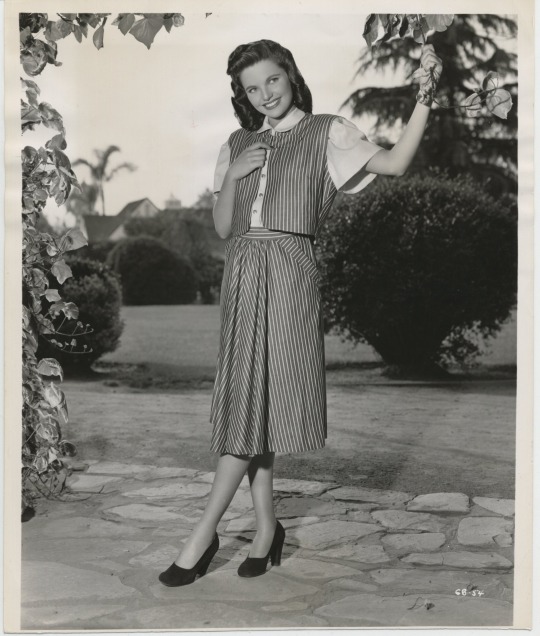
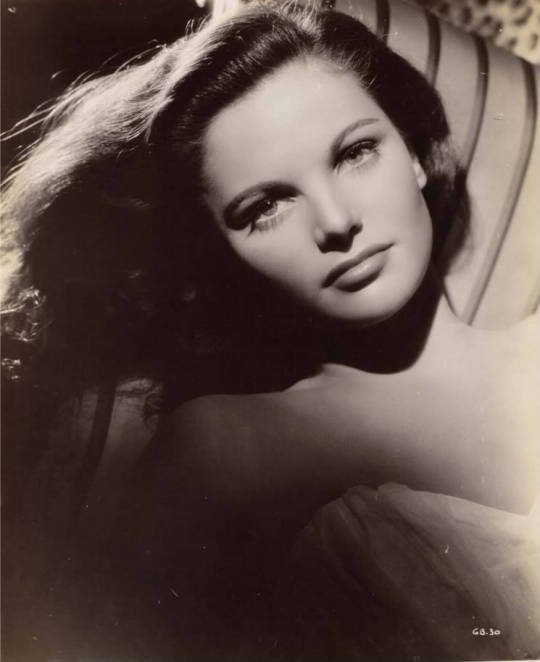


Happy Birthday To Beautiful American Actress Geraldine Brooks
(Born 29th October 1925)
Pics Source: I.M.D.B
#geraldine brooks#birthday girl#born 29th october 1925#beautiful american actress#blue-eyed brunette#american stage - screen - tv performer#3 decades on the american stage#92 acting credits on screen & tv#years active 1947-76#old broadway#old hollywood#old hollywood tv#pics source: i.m.d.b
21 notes
·
View notes
Photo


A very happy birthday to a beautiful man, splendid bowyer and archer, and brilliant, yet frightfully undervalued actor —
Robert Hardy, born on the 29th of October, 1925.
6 notes
·
View notes
Text
10 Unmissable Art Exhibitions Of 2020
10 Unmissable Art Exhibitions Of 2020
Art
by Sally Tabart
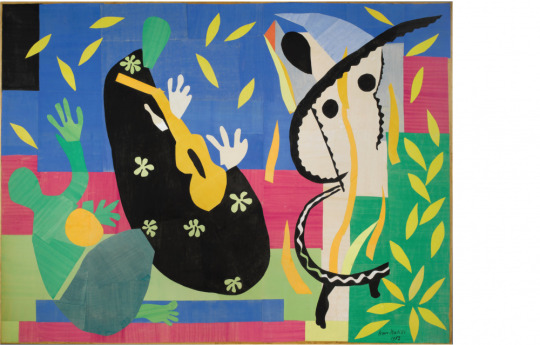
Henri Matisse – ‘The sorrow of the king (La tristesse du roi)’ , 1952. gouache on paper, cut and pasted, mounted on canvas. Courtesy of AGNSW.
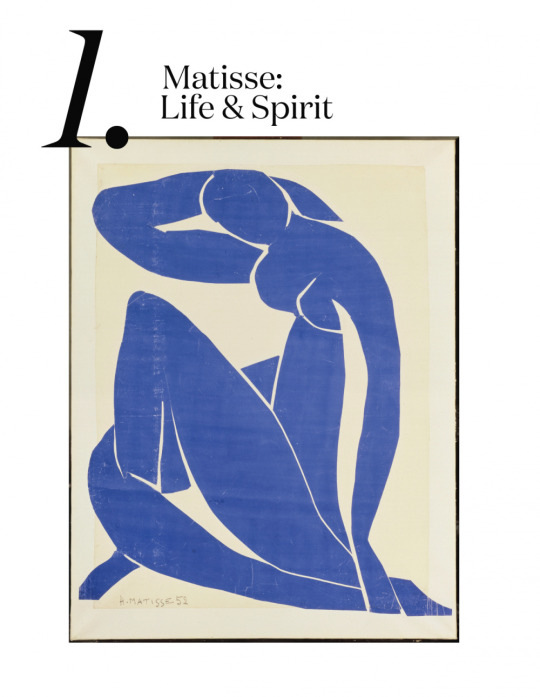
Henri Matisse – ‘Blue nude II (Nu bleu II)’ 1952. Courtesy of AGNSW.
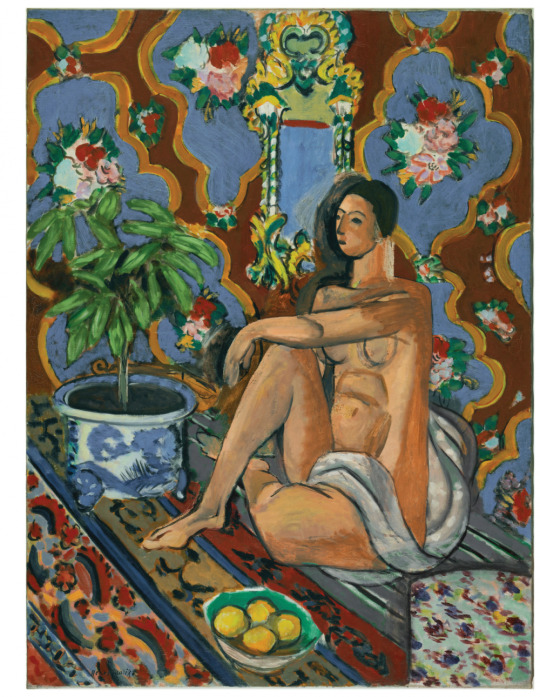
Henri Matisse – ‘Decorative figure on an ornamental ground (Figure décorative sur fond ornemental)’, 1925. Courtesy of AGNSW.
Matisse: Life & Spirit
November 2020 – March 2021
Art Gallery of New South Wales, NSW
It’s no surprise that one of the most prestigious galleries in the country, Art Gallery of New South Wales (AGNSW) will show a dynamic exhibition from one of the most famous and influential artists of all time, Henri Matisse.
Exclusive to AGNSW, Matisse: life & spirit, masterpieces from the Centre Pompidou will show over 100 works spanning six decades from the French master.
Developed alongside the Centre Pompidou in Paris, known for its unmatched collection of Matisse works, Matisse: life & spirit will be the greatest single exhibition of Matisse masterworks ever to be seen in Sydney. Yep – you’ll be able to see his famed cut-outs, but also his adventures in paintings, sculptures, and drawings, tracking the vast and varied exploration of his artistic career. This is TRULY unmissable!

Left to right: Dhuwarrwarr Marika Makassan, swords and long knives, Carlene Thompson, Kipara and Kalaya. Photo – courtesy of MAGNT.
Telstra National Aboriginal and Torres Strait Islander Art Awards (NATSIAA)
August 8th 2020 – January 31st 2021
Museum and Art Gallery Northern Territory, NT
Now in its 36th year, the Telstra National Aboriginal and Torres Strait Islander Art Awards (NATSIAA) is a major highlight for the Museum and Art Gallery of Northern Territory (MAGNT) in Darwin. This fantastic exhibition spotlights emerging and established Aboriginal and Torres Strait Islander artists across a varying range of mediums, and attracts more than 85,000 visitors.
This exhibition is so important for visitors to gain an insight into First Nations People’s perspective in both contemporary interpretations, as well as those steeped in generations of tradition. It also offers some prize money of up to $50,000 for winning artists, courtesy of longtime sponsor Telstra. All finalists’ work will be displayed in the world-class exhibition, opening in August.

Left: Mikala Dwyer: a shape of thought featuring The Angel; Possession; Sigil for Heaven and Earth by Mikala Dwyer, Art Gallery of New South Wales, Sydney, 2017. Photo – Mim Stirling. Right: Julia Robinson, Australia, 1981, Beatrice, 2019–20.
Adelaide Biennial of Australian Art
February 29th – June 8th 2020
Art Gallery South Australia, SA
This year the Art Gallery of South Australia welcomes the hugely popular Adelaide Biennial of Australian Art back for its 30th year. Known for its risk-taking and expansive vision, the Biennial welcomes the wild, wacky, weird and wonderful.
The theme of the 2020 iteration is Monster Theatres, inviting artists to bring to life the ‘monsters’ of today. As described by curator Leigh Robb, ‘Monsters ask us to interrogate our relationships with each other, the environment and technology. They force us to question our empathy towards differences across race, gender, sexuality and spirituality.’
Artists involved in the Biennial include Abdul Abdullah, Polly Borland, Yhonnie Scarce + many more!
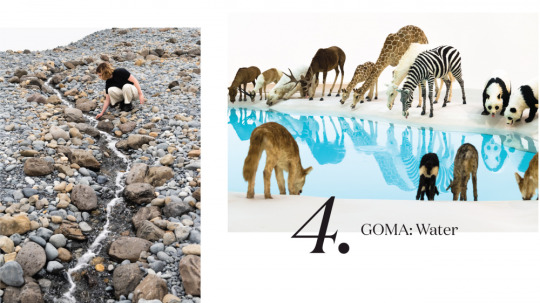
Olafur Eliasson, Riverbed 2014. Photo – Natasha Harth, QAGOMA.
Water
December 7th 2019 – April 26th 2020
Gallery of Modern Art, QLD
Brisbane’s Gallery of Modern Art never fails to disappoint with its innovative, world-class programming – and Water is no exception! Exploring the theme of, you guessed it, Water, this exhibition explores this vital element from the perspective of artists around the world.
Here is some of what you can expect, according to GOMA:
‘Walk across a vast, rocky riverbed created by Olafur Eliasson. See animals from around the world gather together to drink from Cai Guo-Qiang’s brilliant blue waterhole. Gaze at Peter Fischli and David Weiss’s snowman frozen in Brisbane’s summer heat. Traverse a cloud of suspended gymnastic rings in a participatory artwork by William Forsythe. View the tidal currents rise and fall around Angela Tiatia. Reflect on the cultural traditions of bodies of water with Judy Watson, and on the long history of our reliance on water through Megan Cope’s re-created midden.’

Left to Right: Photo by Beth Wilkinson for Lindsay. Stanislava Pinchuk, ‘Topography : Topsoil Storage II, Fukushima Nuclear Exclusion Zone.’ Pin-holes on paper, 2017. Image courtesy of the artist. Photo – Matthew R. Stanton. Stanislava Pinchuk, ‘Topography : The Road to the Fukushima Daiichi Nuclear Plant’. Pin-holes on paper, 2017. Photo – Matthew R. Stanton.
Stanislava Pinchuk
June 27th – October 4th 2020
Heide Museum of Modern Art, VIC
Stanislava Pinchuk (also known by her pseudonym, Miso) has emerged as one of Australia’s intriguing contemporary artists in the last decade. The Ukranian-born, Melbourne-based artist captures the changing topographies of war and conflict zones through data mapping, making tiny, individual pin pricks to realise these patterns – an incredibly labour-intensive and mentally and physically draining process that appears effortless, and beautiful.
This major exhibition at Heide Museum of Modern Art in Melbourne will feature a survey of Stanislava’s most powerful pinprick projects from the past five years, accompanied by terrazzo-like sculptures comprised of pieces of debris left behind in conflict zones.
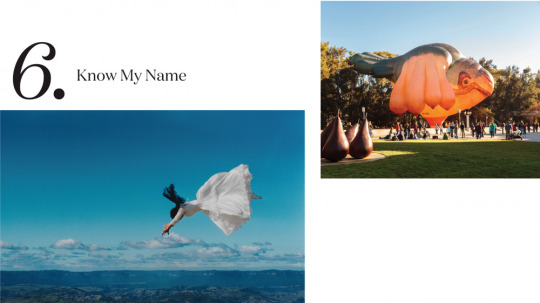
Know My Name: Australian Women Artists 1900 to Now
May 30th – September 13th 2020
National Gallery of Australia, ACT
The National Gallery of Australia (NGA) celebrates its ongoing initiative to increase representation of artists who identify as women with Know My Name: Australian Women Artists 1900 to Now.
Drawing on works from the National Gallery’s own collection, as well as others from across Australia, Know My Name showcases the work of lesser-known artists alongside Australian greats from different times, places and cultures.
As part of the broader Know My Name initiative, a new commission by the Tjanpi Desert Weavers will be on display at the National Gallery. Patricia Piccinini’s iconic Skywhale (2013) will also see its new counterpart, Skywhalepapa (2020) ascend over Canberra on its maiden voyage, travelling alongside Skywhale eight times during the exhibition period.
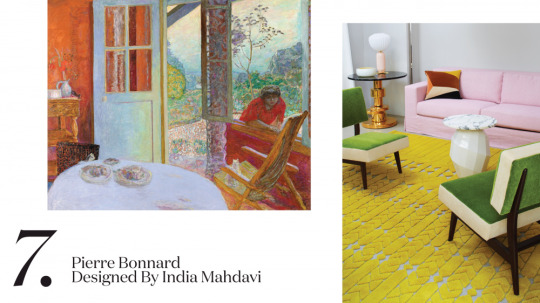
Left: Pierre Bonnard – French 1867–1947 The dining room in the country, 1913. Right: India Mahdavi (designer). Jardin d’intérieur – collection for La Manufacture de Cogolin. Images courtesy of the NGV.
Pierre Bonnard designed by India Mahdavi
June 5th – October 4th 2020
National Gallery of Victoria
While Sydney-siders enjoy the masterful works of Henri Matisse, Melbournites won’t miss out on the opportunity to experience an incredible exhibition of another beloved French painter! The exquisite works of Pierre Bonnard will be on show at the National Gallery of Victoria (NGV) for their major winter showcase, a kaleidoscopic exhibition of 150 works from the painter with a fondness for domestic scenes and rural life. Pierre Bonnard has been developed in partnership with Musee d’Orsay in Paris.
Described by Matisse, a close friend of Bonnard’s, as ‘a great painter, for today and definitely also for the future’, this groundbreaking exhibition spans paintings, drawings, photographs, folding screens and early cinema, depicting scenes of modern 20th century France in bright, vivid colours.
Aside from the opportunity to see one of the works of this beloved painter, what makes this exhibition absolutely unmissable is the design of the show itself. Iranian Paris-based designer India Mahdavi (the interiors genius behind the iconic pink Gallery at Sketch restaurant in London) has been commissioned by the NGV to bring Bonnard’s extraordinary works to life, elegantly balancing historical references with contemporary culture in an immersive experience.

22nd Biennale of Sydney, NIRIN
November 8th 2020 – 16th February 2021
Various locations, NSW
First held in 1973 as part of the opening celebrations of the Sydney Opera House, the Biennale of Sydney is now in its 22nd year and is one of Australia’s blockbuster contemporary art events.
Taking place across six major sites – Art Gallery of New South Wales, Artspace, Campbelltown Arts Centre, Cockatoo Island, Museum of Contemporary Art Australia and the National Art School – the Biennale of Sydney will see 94 artists from 47 countries
Under the guidance of multidisciplinary artist and this year’s Biennale Artistic Director Brook Andrew, the 12-week exhibition is titled NIRIN, meaning ‘edge’ in Brook’s mother’s Nation – the Wiradjuri people of western New South Wales. He says, ‘Optimism from chaos drives artists in NIRIN to resolve the often hidden or ignored urgency surrounding contemporary life.’

Carriageworks Commissions
Rebecca Baumann: Radiant Flux, January 8th – June 14th
Reko Rennie: REMEMBER ME, January 2020 – January 2021
Kate Mitchell: All Auras Touch, January 8th – March 1st
Daniel Boyd: Video Works, January 8th – March 1st
Australia’s largest multi-arts centre, Carriageworks, has been home to some pretty major large-scale installation commissions in its time (who could forget German artist Katherina Grosse’s otherworldly technicoloured universe in 2018?). This summer, four new site-specific commissions from leading Australian artists Rebecca Baumann, Daniel Boyd, Kate Mitchell and Reko Rennie have taken residence in the epic historical space.
Spanning over 100-metres, Rebecca Baumann’s Radiant Flux sees every glass surface of the building’s exterior covered in a film that changes colour at every angle, flooding the space with kaleidoscopic light that will never be the same twice.
A study in human energy, All Aurus Touch by Kate Mitchell captures an aura portrait for each of the 1,023 census-recognised occupations.
Video Works by Kudjala/Gangalu artist Daniel Boyd features three major video installations, where gallery walls will be mapped with the artist’s otherworldly, infinite cosmos.
Interdisciplinary Kamilaroi artist Reko Rennie references the massacre of First Nations people in Remember Me, a massive illuminated sign that will remain on display for the whole of 2020, the year marking the 250th anniversary of Captain Cook’s first landfall.

Installation view of the Archibald, Wynne and Sulman Prizes 2019 exhibition at the Art Gallery of New South Wales, Sydney. Photo: AGNSW.
Archibald, Wynne & Sulman Prizes
May 9th – September 6th 2020
Art Gallery of New South Wales, NSW
The Archibald, Wynne & Sulman Prizes are some of the most prestigious and highly anticipated art events in the country. Since its inception in 1921, The Archibald Prize the most well-known of the three awards celebrates paintings of notable figures that reflect Australian culture across areas including art, media, entertainment, politics, sports and more. The works are always a great capsule to represent Australian culture of the moment.
Finalists for the Archibald (portrait), Wynne (landscape/scenery) and Sulman (genre/subject) are shown in an exhibition that starts at the Art Gallery of New South Wales, and tours at select galleries around Australia for the remainder of the year.
1 note
·
View note
Text
AGATHA BARNES TIMELINE. {1918 - 2014}
November 21st 1918: Sergeant Alec McKinnon and Giovanna Bellini flee discrimination in Europe looking for a new life in America. The pair are expecting twins so hastily settle down in Brooklyn.
December 1st 1918: Elisa and Agatha McKinnon are born.
February 17th 1919: Giovanna returns to work in a local ward, with the help of neighbour Sarah Rogers, a kind woman who had recently lost her husband to the war and left with a newborn. The two grow a strong bond.
March 13th 1919: Agatha McKinnon and Steven Rogers meet for the first time.
October 26th 1923: Giovanna takes Agatha and her sister to their first gymnastics class in Queens.
June 30th 1925: Steve gets into a fight with some bullies at school, James Buchanan Barnes - a boy in the grade above - saves him.
July 4th 1925: Alec McKinnon takes his family to Coney Island, along with Steve for his 7th birthday to which he brings his new friend ‘Bucky’ Barnes who pulls his younger daughter’s pigtails and pokes at her rosy cheeks, he probably just likes her.
July 12th 1925: Agatha McKinnon pushes Bucky into a puddle after he kissed her because Steve said he should, well at least that’s what he told her.
July 24th 1926: Steve, Bucky and the McKinnon girls spend the hot summer day in the street having a water fight.
April 9th 1928: The trio visit Coney Island again, this time unsupervised.
They have an interesting day. First Steve vomited once off the Cyclone, Bucky spent all his money and Agatha accidentally stained ketchup on her pearl white dress. To get home they then had to hitch a ride on the back of a freezer truck.
May 7th 1931: Bucky and Agatha go on their first date of many at the theatre, despite her initial hesitance, it was actually a good time. They go see The Public Enemy starring James Cagney.
September 19th 1931: They become official, much to Steve’s joy and dismay.
August 14th 1934: The couple try and set Steve up with one Agatha’s friends, it goes about as well as you’d think leaving them stuck in the pouring rain after the girl had ran off.
August 29th 1934: Agatha becomes a regional champion gymnast.
December 18th 1934: Bucky and Agatha lose their virginity to each-other.
January 16th 1935: Steve gets into another fight, he manages to run from the bullies.
June 10th 1935: Bucky promises to get Agatha a ring once she’s done with school and they’ll get a big house in country and have twelve little babies running around.
February 23rd 1936: Agatha is offered a spot on the Olympic gymnastics team to compete later in the year. Her friends don’t want her to go, nor do her family. They’d heard the brutal stories of Germany’s narcotic leader, so she decides against it.
October 15th 1936: Sarah Rogers passes from Tuberculosis.
March 12th 1937: Bucky proposes to Agatha after going to see Snow White and the Seven Dwarfs.
December 6th 1937: The pair get married in a local church.
But prior to tying the knot, Bucky tells her about his plans to enlist in the army with her father and that he’d already been accepted; it takes Steve to make sure Agatha doesn’t smack him over the head once she reaches the end of the aisle. Elisa was sure she’d never seen a bride tearing-up before signing the papers.
December 20th 1937: Bucky leaves for Camp McCoy, Agatha refuses to see him off instead locking herself in their shared bedroom. Her father left the week prior, now promoted to Major General back in Scotland.
Time after time Steve attempted to get into the army only to be turned around, selfishly, Agatha was quite glad. She found out she was pregnant soon after and didn’t want to do it without having her best-friend by her side. Plus, as much as she knew Steve’s heart was there he’d be trampled the minute he arrived, with no Bucky.
August 27th 1938: Marie Ellen Barnes is born.
September 3rd 1939: Alec McKinnon is deployed onto the front-line as Britain announce war on Germany. Agatha and her sister have both started working for the local hospital, following in their mother’s footsteps.
January 6th 1941: Alec McKinnon is declared a Prisoner of War after losing to Japan in Singapore.
May 26th 1943: Bucky returns home for the first time in years before deploying to the UK.
He to sees his three-year-old daughter for the first - and final - time. The trio visit the Stark Expo and the usual banter ensues but when the couple arrive home Agatha makes it clear, once again how she feels about the war and warns Bucky to caution after what happened to her father and she doesn’t want to see him suffer the same fate to keep her content he leaves his dog-tags with her.
October 2nd 1943: Bucky becomes a Prisoner of War, unbeknown to Agatha who has been left alone once Steve managed to get into the army.
November 13th 1943: Steve saves Bucky as Captain America, they return to camp.
February 22nd 1945: Bucky Barnes is pronounced dead, Steve lets her know over the phone.
March 1st 1945: The Winter-Solider Program begins.
April 16th 1945: Armin Zola locates a distraught Agatha Barnes after beating it out of Bucky when he refused to cooperate.
April 19th 1945: HYDRA capture Agatha on the street and begin using her to force Bucky back into the brainwashed state, using her screams as a clear trigger. When he heard it, it would force his brain to forget and they’d stop hurting her. As the years went by he did just forget why it would alter him because he hadn’t ever seen Agatha since 1943.
By 1955 HYDRA had managed to keep Bucky’s psyche under-control meaning there was no longer need for Agatha so, instead of risking a breach they shoved her into a cryogenic freezer except this time it wouldn’t be re-opened, leaving her trapped in the body of a twenty-six-year-old.
During this period, some of the bacteria left in her scars fused with what HYDRA had been injecting her with so with the combination of the ice was able link with her body without her knowledge - this gave her, her freeze-power.
September 4th 1945: Alec McKinnon returns home from a war-camp in Japan with three fingers chopped off and the loss of sight in an eye. Only to find one of his children missing, and her daughter being looked after by his other daughter.
November 17th 1970: Giovanna Bellini passes from lung cancer.
July 31st 1972: Alec McKinnon passes from natural causes.
March 28th 1996: Elisa McKinnon passes from lung cancer.
November 1st 2010: On a simple recon mission agent Natasha Romanoff locates a living being in a freezer beneath a supposedly abandoned warehouse, she reports back to Nick Fury. Once out of the tube, their only form of identification; the dog-tags that hung from her neck reading Sgt. J. B. Barnes.
November 4th 2010: Agatha Barnes is freed for the first in 55 years.
November 10th 2010: There is a freak accident in the Shield headquarters after Agatha has a panic-attack in her new, modern surroundings. She’d created a catalyst of smashed windows cause by a mixture of a sudden temperature drop and sharp icicles.
December 23rd 2010: Once safely relocated Agatha back in Brooklyn, she begun actively looking for what remained of her family, including her daughter.
March 5th 2011: Agatha is finally reunited with Marie, as well as her grandchildren and some great-grandchildren, they devise a plan so Agatha can act as their aunt - rather than an ninety-two-year-old great-grandmother that didn’t look a day over 30.
October 4th 2011: Steve Rodger’s body is found.
October 26th 2011: Agatha and Steve meet again, they tell each-other conflicted stories about Bucky, though both presume he is dead. Agatha believing HYDRA killed him - that’s why they disposed of her and Steve is positive he watched him fall to his death.
January 19th 2012: Agatha is approached by Nick Fury about the Avengers-Initiative. She sternly declines not interested in harnessing her powers and wants to make-up for lost time with her family, despite his protests he eventually gets the message.
April 22nd 2012: HYDRA agents hidden amongst SHIELD ambush Agatha in her home with the intent of recapture, they all end up dead after she has a mental snap.
July 24th 2013: Steve has a go himself trying to get Agatha to better her powers for the greater good, telling her how proud it would make Bucky.
January 10th 2014: Now in full control, Agatha joins Steve, Natasha and Sam Wilson in order to find out who is after Fury.
January 11th 2014: The Battle of Washington. After Natasha has been compromised, Agatha stepped in to fight the masked-man whilst Steve was preoccupied. It was the first she’d be properly pushed harm but after some bad footing, she was down and at wrong end of a handgun. Thankfully Steve’s shield knocked him off her. Once rejoining the fight the two play essentially a tag-team, one out, one in. Then, the mask came off. She genuinely believed her heart stopped.
January 15th 2014: Steve and Agatha begin their search for the Winter Soldier.
3 notes
·
View notes
Text
relatives and birth and marriage and death and other dates.
Nikolai D.enkin: born (created?) circa fuck knows when, pre-1700s maybe. left the circus, let’s say, early 20th century. met Dolores Egan in 1945. married 4th May 1947 in Bootle. died in August 2004.
Albert Duncan F.olger: born 9th July 1922. met Anna in January 1943. married 26th May 1943. died 5th August 1960.
Anna Louisa F.olger, nee Butcher: born 5th March 1923. met Albert in January 1943. married 26th May 1943. died 5th August 1960.
Grady Kelly McNab: born 3rd June 1923. met Lindsay in 1934. married Lindsay 11th December 1945. died 10th January 1980.
Lindsay Isobel McNab, nee Rainey: born 7th February 1924. met Grady in 1934. married Grady 11th December 1945. died. 7th February 1977.
Dolores Claire D.enikin, nee Egan: born 15th September 1925. met Nikolai in 1945. married 4th May 1947. died 30th December 1990.
Desmond F.olger: born 7th November 1943 to Albert & Anna, older brother to Diana, Donovan, & Dorothea. met Samantha in 1966. married 8th May 1968. died 4th August 2001.
Samantha Louise F.olger, nee McNab: born 26th July 1946 to Grady & Lindsay, older sister to Amanda & Danielle. met Desmond in 1966. married 8th May 1968. died 4th August 2001.
Diana Margaret F.olger: born 28th November 1946 to Albert & Anna, younger sister to Desmond, older sister to Donovan & Dorothea. died 5th August 1960.
Donovan Gordon F.olger: born 12th July 1948 to Albert & Anna, younger brother to Desmond & Diana, older brother to Dorothea. died 5th August 1960.
Dorothea Minerva F.olger: born 1st February 1951 to Albert & Anna, youngest sister to Desmond, Diana, & Donovan. died 5th August 1960.
Adrian William B.anks: born 1st January 1949. met Lauren in 1965. married 17th May 1971. died 31st December 2014.
Lauren Marguerite B.anks, nee Langley: born 3rd February 1949. met Adrian in 1965. married 17th May 1971. died 6th July 1990.
Mark Nicholas D.enikin: born 29th August 1950 to Nikolai & Dolores. met Amanda in 1977. married 3rd January 1980. died 5th October 2013.
Amanda Louise D.enikin, nee McNab. born 2nd May 1952 to Grady & Lindsay, middle sister to Samantha and Danielle. met Mark in 1977. married 3rd January 1980. died 10th February 2010.
Danielle Louise McNab: born 15th April 1960 to Grady & Lindsay, youngest sister to Samantha and Amanda. died 31st December 2008.
Graham F.olger: born 2nd September 1970. met Oliver in 1994. became boyfriends with Oliver in 2000, split up in early 2006. (kinda-)died 7th April 2006.
Oliver Adrian B.anks: born 13th April 1973 to Adrian & Lauren. met Graham in 1994. became boyfriends with Graham in 2000, split up in early 2006. died in early (January or February) 2018 but got better.
Joshua D.rury: born 14th February 1979. met Leanne in early 2004. died around August or September in 2004.
Leanne Marie D.enikin: born 15th November 1980 to Mark & Amanda. met Joshua in early 2003. still alive.
#headcanon.#(no ic content just halfassed bullshit)#long post cw#death mention cw#child death mention cw#(re: death dates)
0 notes
Text
Anne Huggins Byce
On Friday, July 19, 2019, Anne Huggins Byce departed this life peacefully at her home to join her Heavenly Father. Born in Laurens, South Carolina on October 29th, 1925, she was the daughter of the late Margaret McCord and John Cortsworth Huggins and the widow of Macon Earle Byce, Sr. Anne graduated from Spartanburg High School and worked at Smith Drugs before marrying her handsome Marine in 1946. Anne worked tirelessly alongside him in their business, Main Finance Company, and kept the company running for ten years after his death. Anne & Macon were Charter Members of Westminster Presbyterian Church in Spartanburg and were the Adult Leaders of the Church’s Youth Fellowship for many years. She worked selflessly for various organizations but by far, her favorite was the Mothers March of Dimes, always working quietly to better the lives of others. She will always be fondly remembered for her sweet giving spirit and devotion in raising her family and numerous friends of her children. All were always welcome in her home. She is survived by her four adoring daughters; Karen Byce Ramsaur (Ted) of Cedar Mountain, NC, Glenna Byce Cox (Bobby) of Duncan, SC, Debra Lynne Byce (Chris Biggerstaff) of Spartanburg, SC, Donna Howell Byce of Cedar Mountain, NC; a special niece, Glynda Byce Jolly (Bruce) of Atlanta, GA; two grandchildren, Macon Earle Byce III (Kathryn) of Spartanburg, SC, and John Moore Byce (Helen) of Greenville, SC; and three great grandchildren, Caroline Byce of Spartanburg, SC, Calvin Byce and Heyward Byce, both of Greenville, SC; her sisters, Evelyn Shirley of Boiling Springs, SC, Mary Bremer of Cowpens, SC and Barbara Huggins of Spartanburg, SC; numerous nieces and nephews, each one special to Anne as well as many dear friends like Sandy Wheeler and Ruby Burrell. She was predeceased in death by her daughter, Cheryl Byce, her son, Macon Earle Byce II, and her brothers, John Huggins and Hugh Huggins. A Celebration of Life Service will be at 3:00 PM Tuesday, July 30, 2019 at Westminster Presbyterian Church, 309 Fernwood Drive, Spartanburg, SC 29307, conducted by a family friend, The Rev. Dr. James C. Hilton. The family will receive friends at the home, 1775 Hillcrest Blvd., Spartanburg, SC 29307 immediately following the service. The family would like to thank special caregivers Rhonda Wilder and Sharon Hardy. In lieu of flowers, the family request memorials be made to Spartanburg Humane Society, 150 Dexter Road, Spartanburg, SC 29303. Anne will always be greatly missed and surely never forgotten by all that had the pleasure of knowing her. Floyd’s Greenlawn Chapel
from The JF Floyd Mortuary
via Spartanburg Funeral
0 notes
Text
Colin Eglin, the long time anti-apartheid campaigner and long time leader of the opposition Democrats in South Africa has recently had a road named after him … but so what! Many streets and roads are named after various politicians in South Africa, especially the anti-apartheid campaigners in recent times … however, this one is different, very different.
Why? because Colin Eglin Road is not in South Africa, it’s in Italy.
Most modern South Africans who can even recall him, just know him as part of the last vestige of ‘white liberals’ in a ‘whites only’ Parliament trying to hold the juggernaut of the National Party and its Apartheid policy to account. A tiny voice calling for full democracy in a sea of National Party (NP) rural ‘afrikaner-bloc’ gerrymandering which overtook him and pushed the ‘official opposition’ i.e. the PFP (now the DA) and the more liberal ‘english-bloc’ urban voters calling for an end to Apartheid into complete political irrelevance.
Note – this gerrymandering (the weighting and re-drawing of constituency boundaries to create a favourable political bias) which the NP used to destroy Colin Eglin and the PFP using the ‘rural bias’ is now happily used by the ANC and this last significant footprint of Apartheid has been put to good effect keeping the DA’s ‘urban’ vote ineffectual.
So, gerrymandering has resulted in well-regarded South African politicians been sidelined – what it did to the ‘democrat’ opposition bench then, it also does to them now. You may now even have to ask ‘Who is Colin Eglin anyway?’ and how is it that Colin Eglin became so revered that the Italians have named one of their streets after him?
That bit has a lot to do with Colin Eglin’s status as a military veteran and his tireless campaigning for South African military veteran recognition and the causes they fought so hard for in the mountains of Italy.
Now, who even knew Colin Eglin was a 2nd World War veteran? Lets examine what drove this most complex war veteran turned political campaigner.
Background
Colin Wells Eglin was born on 14th April 1925 in Sea Point, Cape Town, at a young age he moved to live with his aunt, outside Hobhouse, Eastern Free State when his father died after a long illness. Colin attended the Hobhouse School where he was the only English–speaking pupil – “I found myself the only rooinek (red neck, or English-speaker) in the village school.” he later lamented and he very quickly came to learn of the ‘Afrikaner politics’ and tension between the National Party supporters of DF Malan and those of Barry Hertzog – politics which began to deeply affect him. It also him the rare advantage of being fully fluent in both English and Afrikaans.
Colin was a bright and highly intelligent pupil and he left the Orange Free State and attended the De Villiers Graaf High School in Villiersdorp where he matriculated in 1939 at the very young age for a matriculant – only 14 years old.
Colin Eglin during WW2
South Africa had gone to war when Colin matriculated, at 14 years old he was too young to join the army, so in 1940 (now aged just 15) Colin Eglin registered for a Bachelor of Science degree in quantity surveying at the University of Cape Town (UCT). In 1943, now finally at the recruitment age of 18 he interrupted his studies at UCT to fulfill Jan Smuts’ call to go to war, and he voluntarily joined the army.
World War 2
Colin initially became a full-time instructor in the anti-aircraft unit in Cape Town. He was then sent to a similar unit in Egypt and transferred to Italy in 1944 joining the 6th South African Armoured Division fighting in the Italian Apennines around Florence. Now a 19-year-old ‘rookie’ soldier, he was to be baptised in the last significant combat operations of the war and was front and forward in the South African assault on Monte Sole.
Colin Eglin had joined ‘D Company’ of an amalgamated Cape Town Highlanders (CTH) and First City (FC) from Grahamstown unit which had formed a combined regiment for service in the 6th South African Armoured Division.
The Cape Town Highlanders (CTH) and First City (FC), known collectively as ‘FC/CTH’ had just previously acquitted themselves very well under the command of Lt Col. Angus Duncan in the taking of Monte Stanco from strong German positions and at this stage the war had entered a static winter period before the next big push onto Monte Sole.
As Colin had completed four years university study at UCT in quantity surveying it was felt that he had sufficient qualification for ‘Battlefield Intelligence’ and he was put on a course to become ‘D’ Company’s intelligence corporal (the military – then and now – often displays this odd logic for placing individuals civilian qualifications for military needs).
Colin was taken to the ‘Pink House’ near Grizzana, a farm building that was also the operational HQ of ‘C’ Company for a crash course of two weeks training in ‘Battlefield Intelligence’ and then back to D Company.
‘D’ Company had its headquarters in a cluster of farmhouses, named the ‘Foxhole’, on the slopes of the mountain overlooking Grizzana. As it was in the line of fire of enemy positions, ‘Foxhole’ was a tough, cold and miserable posting. Colin found himself in a forward observation post (OP) located at the cemetery at Campiaro. The OP overlooked the town of Vergato which was the centre of the German defences in the area.
In the freezing weather, snow and mud guard duty and patrols by D company in the area were a miserable affair. Patrols were sent out at night, and they almost always hit fierce and lethal contacts with the German defenders. In these patrols and observations Cpl Colin Elgin became adept at map reading and at recognising, and noting, the sounds and sights of warfare.
Much needed ‘Rest and Recuperation’ (R&R) came around every two weeks when ‘D Company’ members would go to nearby Castiglione dei Pepoli, the South African 6th Division HQ was located there and they could shower, get fresh supplies and spend some time relaxing. Known to the South African soldiers as ‘Castig’ the town of Castiglione dei Pepoli was to become a central feature in Colin Eglin’s life for years to come.
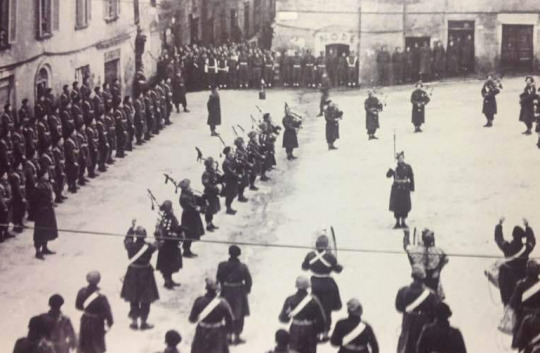
The South African 6th Division in the town square of Castiglione dei Pepoli – 1945.
In the valleys around Monte Sole, between the 29th September and 5 October 1944 the Italian resistance kicked into action, this then spurred the defending German forces into an extreme action to control the area. They embarked on massacre, and proceeded to try to wipe out all Italian civilians around Monte Sole – resistance, men, women and children (all of them – it mattered not a jot). The town of Marzabotto alone commemorates the massacre of 770 individuals, mostly the elderly, women and children.
With the static winter period over, by the spring of 1945 the South African 6th Division could advance on Monte Sole. In April 1945 Colin Eglin joined a CTH/FC forward party for a briefing on the assault on Monte Sole by Colonel Angus Duncan.
Colin noted “In a few weeks’ time the Allied spring offensive would commence. The Sixth Armoured Division had been given the task of opening the road to Bologna. To do this, the Twelfth Brigade would have to capture the mountain massif formed by Monte Sole, Caprara and Abelle. The Highlanders had been assigned to capture Monte Sole. Suddenly that mountain we had gazed at all winter from a safe distance was in front of us. Forbidding, frightening, challenging. Casualties were likely to be heavy. Yet there was a sense of pride that our regiment had been chosen for this pivotal battle task, and quiet determination to show we could do it”.
The South African 6th Division attack in Spring 1945 was a two-pronged affair, the Cape Town Highlanders and First City (FC/CTH) were to take Monte Sole – regarded as the most formidable of the German Army defences, and Witwatersrand Rifles/Regiment de la Rey (another amalgamated unit) i.e. WR/DLR were to take Monte Caprara. The idea was to eventually push through and capture the crossings of the River Po and break out into the vallies and plains beyond the mountains.

Looking more like partisans than regulars, a First City/Cape Town Highlanders patrol sets out in the italian Apennines – 1945. SANDF Archive
To prepare for the attack on 15th April 1945, the German defensive positions were bombed from the air and shelled by artillery. In taking Caprara, the WR/DLR suffered heavy casualties right from the start and in desperate fighting which at time even involved hand-to-hand combat, they took the mountain. Counter-attacks by German forces were effectively fought off by the South African tenaciously holding on to their win.
Colin Eglin was assembled at the start-line for FC/CTH attack on Monte Sole at Casa Belvedere (two kilometers from the peak of Monte Sole). He had just celebrated his 20th birthday the day before.
Both ‘C’ and ‘D’ companies of FC/CTH advanced along two farm tracks leading up to the summit on Monte Sole. They re-assembled 800 meters from the crest of Monte Sole. The area was heavily mined by Germans, but despite this the South Africans of C and D company advanced under the command a 20-year-old rookie officer with only 12 days front line combat exposure. 2nd Lt. Gordon Mollett led the charge up the approach with only five men and ‘with total disregard for his life’ wiped out the machine gun posts on the crest of Monte Sole with the loss of one of his men.
So swift was the assault on the German’s position that they were completely unprepared for proper defence or the bayonet charge, and with that 2nd Lt Mollett walked into South African history with a DSO (Distinguished Service Order) for his actions and the rest of C and D companies of the FC/CTH took the crest and won the day.
Preceding the final attack on Monte Sole, Colin Eglin had been tasked to install telephone lines as far up the route as possible. Highly dangerous work, on his way up to Monte Sole the soldier walking just behind him stood on a German anti-personnel Schützenmine 42 mine. Also known as a Schuh mine (shoe mine) it is a simple wooden box with a hinged lid containing a 200-gram block of cast TNT and a ZZ-42 type detonator, and it blew off part of the South African soldiers foot.
Colin applied an emergency field dressing to his wounded comrades foot, administered first aid and called for a stretcher-bearer. Even with the threat of mines now highly apparent Colin and couple of ‘D’ Company platoons continued to press forward to the summit. Colin was able to get to the top and rigged up his field radio under fire, only to have its aerial cut in two by all the shrapnel and bullets flying around, thus rendering it useless. So he scrambled down the mountain to the HQ, it was here that he took in the news of the tragic death of his Commander – Lt Col Angus Duncan. He was killed the foot of Monte Sole when his jeep was blown up It is thought that the jeep carrying Lt. Col Duncan hit a mine, while other witness accounts suggest an artillery round fired from a German 88 mm anti-aircraft and anti-tank artillery gun across the valley hit the vehicle.

Officer Commanding First City/Cape Town Highlanders, Lt Col Angus Duncan, addressing his men before the assault on Monte Sole. He was killed shortly after this photograph was taken, while driving to his brigade’s position. SANDF Archive
Many years later in Peter Elliott’s interview with Colin Eglin (then Colin was 88 years old and this was his last visit to Italy), whilst the two of them re-traced the steps of FC/CTH at Monte Sole, Colin recalled how the strain of war impacted two completely different soldiers and comrades, Jan and Peter. Jan was a tough outdoors man, an extrovert and he relished army life prior to the battle. Peter was a indoors man, an introvert who just endured army life out of a sense of duty. During the battle for Monte Sole battle it was Jan, the extrovert whose nerves snapped, and he had to be withdrawn from battlefield. Colin found Peter, the introvert some time later still in his slit trench. He had been under intense mortar fire during a number of German counter-attacks, but remained resolute. He was exhausted but even cheerful and shouted across at Colin triumphantly, ‘Corporal, we made it!’
Even though the taking of the crest had been swift, the Battle for Monte Sole was heavy and hard going, in all FC/CTH suffered heavy losses – a total of 31 men killed and 78 men wounded. The extent of contribution of the two Regiments to the battle and victory can be seen in the bravery – in all twelve gallantry medals and awards were won.
The capture of Monte Sole by FC/CTH opened up the road to Bologna and beyond the Po Valley, within two short weeks on 2 May 1945, the Germans formally surrendered in Italy. For the South Africans it was effectively war over!

‘D’ Company FC/CTH HQ Melzo, Italy, a week after war ended in May 1945. Colin Eglin is fourth from right, back row.
But a new struggle was emerging for these newly minted war veterans, certainly for Colin Eglin. After the War Colin remained in Italy for nine months, he was stationed at Castiglione dei Pepoli, the town located near Monte Sole remained the South African 6th Armoured Division’s headquarters and it now became a depot and clearing station for the entire division (in fact the main South African military burial ground in Italy is located there). During this period, whilst waiting to be demobilised he undertook extra-mural courses in Archaeology and Town Planning.
The entire event had made an indelible impression on Colin’s soul, it was the Italian Campaign that was to deepen his commitment to democracy and liberty. Monte Sole was a shrine for him as he returned there on many occasions during the next sixty-eight years to stand gazing at the mountain where, as a young man, he quickly became an adult. During these trips he was also to build a lasting relationship with the towns-people of Castiglione dei Pepoli.
A military veteran’s legacy
In his autobiography, “Crossing the Borders of Power – The Memoirs of Colin Eglin,” Colin mentions the discussions that took place among the South African soldiers in 1945, whilst in Italy waiting to be repatriated to South Africa. Colin noted:
“The dominant view was that there should be a memorial, but that this should be a ‘living’ one that served the community, not merely a monumental structure. The servicemen, in overwhelming numbers, volunteered to donate two days’ pay towards what was to become the Red Cross War Memorial Children’s Hospital.”
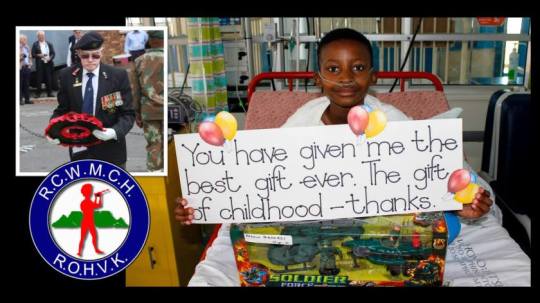
For more on the Red Cross War Memorial Children Hospital follow this link to the related Observation Post; A war memorial in Cape Town which saves children’s lives
The children’s hospital was to be built as a memorial to those who had contributed by sacrifice, suffering and service in the Second World War, the soldiers felt that children had been the innocent victims of the war and the Red Cross War Memorial Children’s Hospital was devoted to the relief of the suffering of children.
The building of the Children’s Hospital in Cape Town commenced in 1953 under the guidance of the South African Red Cross Society and remains a ‘living war memorial’ helping the most vulnerable of the community – our children – and Colin Eglin was to play a leading role in making it happen.

Colin Eglin speaking at the Red Cross Children’s Hospital in Cape Town on Remembrance Day
During his life-time Colin returned to the Italian Apennines and Castiglione dei Pepoli over ten times. For his work on Remembrance and maintaining the links of this part of Italy with their liberators – South Africa – he was even made an honorary citizen of the town of Grizzana Morandi.
But why was an opposition party leader elevated to such a significant position in Italy and not a government one? We all know the answer to that, as the Nationalist Party had no really sincere intentions on commemorating South Africa’s war against Nazism and Fascism in Italy, before and during the war they had supported the ideals of Nazism and Fascism. They were not going to change their stance on Britain, British Allies, Smuts, World War 2 or even Fascism. So this key task on building on the South African sacrifice in Europe, lest it all be in vain, was left to that part of the South African mainstream party political spectrum which supported Smuts and all the ‘liberals’ who went to war against Nazi Germany – and that part of the party political spectrum in 60’s, 70’s and 80’s was Colin Eglin’s turf.
The political path for Post War veterans
In 1946 Colin returned from the Italian theatre of Military Operations to South Africa, here he picked up where he left off and continued with his studies, graduating the same year with a B.Sc in Quantity Surveying from UCT.
He became involved in civic affairs and started the Pinelands Young People’s Club which helped set up a sister organization in the neighbouring Coloured village of Maitland. In 1951 he became chairman of the Pinelands Civic Association and was elected to the Pinelands town council.
The electoral loss of the Jan Smuts’ United Party in 1948 to the National Party and their Apartheid proposals sent shock waves into South Africa’s war veteran community. The war for liberty and democracy they had conducted overseas in places like Italy, against the same forces of fascism which had now come home to roost in South Africa. This spurred The Torch Commando in the early 1950’s led by Sailor Malan and Colin Eglin as a returning war veteran joined The Torch Commando and started to become very politicised.

The Torch Commando was the first anti-Apartheid mass protest movement, and it was made up of returning war veterans. It was primarily a ‘pro-democracy’ movement and was crushed by the National Party because of the military threat it posed – and it was done by using ‘anti-communist’ legislation designed to curtail any ideology in opposition to Apartheid.
The Torch Commando was linked to the United Party, who tried to leverage it for the ‘service vote’ and wrestle power back from the National Party. In 1953 Colin decided to enter in formal political party opposition to Apartheid in addition to protesting with The Torch Commando – and he joined Smuts’ United Party (Smuts had just passed away in 1950). Almost immediately he became the political campaign manager for his friend Zach de Beer who was the United Party (UP) candidate for the parliamentary seat of Maitland. Colin Eglin and Zach de Beer were to form a friendship and political bond which would transform itself into what is now the modern “Democratic Alliance’.
In 1954 Colin himself was elected unopposed as the UP provincial councillor for Pinelands. In addition to that, he became chairman of the UP’s Cape Peninsula Council and then in 1958 Eglin became the Peninsula MP.
By August 1959, following the United Party’s congress in Bloemfontein, Colin broke from the UP ranks, the new guard in the UP instead of following Smuts’ vision of universal suffrage and holistic reconciliation in South Africa, still humoured the more conservative elements of the party who wanted a limited franchise and some restrictive movements for South Africa’s black migrant working population – a sort of ‘Apartheid Lite’ if you will.
In 1959 this was clearly no longer the direction needed or in any way relevant for liberal and democratic opposition parties in South Africa. Colin was one of UP rebels who issued a declaration of dissent (the others included Zach de Beer and Helen Suzman).
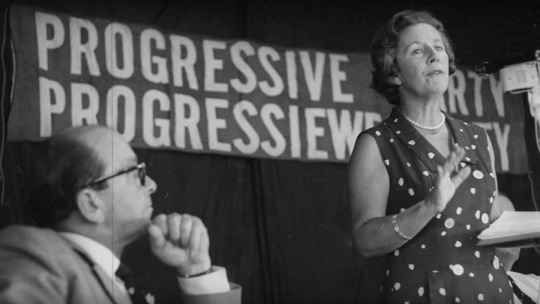
Helen Suzman at a Progressive Party meeting
In November that year he was one of the 11 members of parliament who formed the nucleus of the new Progressive Party (PP). It was a bold move, it would ultimately spell the end of the United Party and the conservative element within it, also by fractionating the official opposition (the UP) it certainly bolstered the National Party. What it did however also do was draw the line in the sand of ‘white politics’ – on the one side, the whites who supported Apartheid and a whites only vote and on the other side whites who did not support Apartheid and wanted a democratic vote for all.
All through this Colin Eglin never wavered from his adherence to liberal, democratic values, he aimed to reform the system from the inside; and by balancing criticism of race discrimination with political pragmatism he sometimes found himself the subject of attack from both black and white communities.
The ANC would argue that by participating in the apartheid political system, no matter what his stance, Eglin helped perpetuate it. Yet by participating Eglin was also able to work against the Apartheid government machine and make important political gestures – such as his visit to the black activist Steve Biko, or sending ‘official government opposition’ delegations to promote the dismantling of Apartheid in the so-called ‘independent’ Bantustan ‘homelands’ and promoted dialogue with urbanised black leadership.
By 1966 Colin Eglin became chairman on the National Executive of the Progressive Party (PP) and in 1971 he became the party leader succeeding Jan Steytler. In an attempt to attract Afrikaners to the PP, he initiated ‘Deurbraak’, the first journal of verligte (enlightened) opinion in South Africa. Colin Eglin also initiated a dialogue between the PP and Black homeland and urban leaders. He was also instrumental in establishing Synthesis, a non-party political study and discussion group, which became an important tool for information and contact across the colour bar. He also held a symposium of 50 Afrikaner academics in 1971, from which a non-party-political movement, Verligte Aksie, was formed.
In 1974 the PP won six seats in the general election with the seventh coming from a by-election a few months later. In 1975 Eglin negotiated the merger with members of the Reform Party, which led to the formation of the Progressive Reform Party (PRP). In 1976 he called an Extraordinary Parliamentary session to discuss the Soweto Uprising and call for the resignation of the Minister of Bantu Affairs, M.C. Botha.
A combination of gerrymandering by the National Party and totalitarian crack-down by the Apartheid State of South Africa’s liberal ‘democratic’ politicians, gagging many of them by way of banning and sending many into exile after the Sharpville massacre in 1960, saw liberal politics in a racially segregated and conservative Afrikaner biased voting sphere become absolutely irrelevant – and the PP would eventually lose all its seats, except one – Helen Suzman – who remained a lone voice of official opposition to Apartheid in Parliament for many years.
Also for many years, while she was the Progressive’s sole MP, Colin Eglin acted as Helen Suzman’s link with extra-parliamentary activities. He travelled extensively in Africa, Europe, America and even China. During visits to 15 African countries, as official government ‘opposition’ to the National Party he met many heads of state to drive international opposition to Apartheid – and he did this using official and politically legal channels – without having to resort his party to violent opposition.
Criticism of the PRP by the National Party as they tried to brand then as a “Tool of Communist agitators.” was swiftly put in place by Suzman who said .. “it’s really a joke, isn’t it? Because, quite clearly, we are a party of real moderates. It just shows how little they understand.”
In 1977, following a merger with the Committee for United Opposition that had also broken away from the United Party the PRP became the Progressive Federal Party (PFP). By 1979 Colin stepped down as leader in favour of Dr F van Zyl Slabbert and became Shadow Foreign Minister, a post he would hold until 1986.

In 1986 Colin Eglin found himself at the reigns of his party again following the shock resignation of Van Zyl Slabbert from the PFP. Ironically van Zyl Slabbert had one crucial deficiency, which Eglin had in spades – staying power. Eglin, on one occasion described the pursuit of the liberal cause on the stony soil of South Africa as “the politics of the long haul”. And when Slabbert, despairing of making any change to the Apartheid machine quit the leadership in a fiery act of self-implosion it was again to Eglin that his shell-shocked colleagues turned to give the lead.
He remained party leader until 1988, however he didn’t have the best people skills to sustain this type of leadership. Affectionately known as ‘the Egg’, Colin Eglin had a sharp tongue and bit off many heads. His long-time colleague Helen Suzman admitted that his manner “put off a lot of people. Yet we all came back to “the Egg”, not only because he was a role model for progressives, or because of his intelligence and measured political judgment, but because he was a decent, very warm-hearted man, whom we held in great affection.
In 1988 his old UP friend, a veteran of democratic politics – Zach de Beer, took over from Colin as the newly elected party leader of the PFP. With seismic political changes on the horizon, in 1989 Colin Eglin focused on preparing his party enter into a meaningful role in South Africa’s democratic evolution, to do this he knew he needed other democratic bodies in coalition with the PFP – so he negotiated with the Independent Party and National Democratic Movement to bring together a new opposition to the National Party in parliament.

This resulted in the formation of the Democratic Party (DP) in 1989 and the dissolution of PFP. Colin was subsequently elected chairperson of the DP’s parliamentary caucus, and Zac de Beer took control of the reigns of the DP as leader.
Building Democratic opposition in a new epoch
In 1991, as the Democratic Party (DP) stalwart, Colin participated in the Convention for a Democratic South Africa (CODESA) and served in its working group. Described by Nelson Mandela as “one of the architects of (South Africa’s) democracy”, Colin Eglin played a leading role in the drafting of the country’s post-apartheid constitution.
It was in CODESA at Kempton Park that Colin came into his own. It has been said that it was as though his life to then had been preparation for just this moment. Much of South Africa’s much praised liberal constitution is due to Colin’s clear grasp of the principles of liberal democracy and the constraints and provisions of those institutions charged with protecting and advancing these.
Colin’s negotiating prowess was recognised by Joe Slovo in particular and, when an impasse was reached, the two would get together and generally find a way forward and eventually, a worthy constitution was to emerge. His intellect, presence and engaging manner were recognised and respected by all in those crafting the new democratic Constitution and Bill of Rights in the tumultuous years of 1990 to April 1994.
Colin Eglin continued to serve in the segregated House of Assembly until it was abolished in 1994 after the historic democratic transition and vote in South Africa, and Colin then served in the multi-racial National Assembly as a DP Parliamentarian.
In November 1994, at the end of the first session of South Africa’s first democratic Parliament, a small group of Democratic Party MPs to have lunch in Pretoria with President Nelson Mandela to discuss some challenges affecting the new legislature.
On arrival, in the dining room at the official residence, Mandela arranged the seating with this instruction: “Colin, you sit at the head of the table – you are the senior man here in terms of service.”
Mandela was giving recognition to a veteran anti-Apartheid stalwart, a person who had first been elected to Parliament fighting Apartheid tooth and nail some 36 years before this luncheon and a person whose Parliamentarian career would even outlive Nelson Mandela’s own after the luncheon was over. It was some acknowledgement to ‘the Egg’ and South Africa’s democrats and Mandela knew it.
In 2000, the DP merged with other groups to become the Democratic Alliance (DA), which survives as the current official ‘democratic’ opposition to an African National Congress (ANC) government.
Whilst in the DA, Colin turned his attention on the new ‘Nationalists’ in Parliament, where the Afrikaner Nationalists (NP) were his previous foe, the African Nationalists (ANC) were his next. To Eglin – nationalism almost always meant one-upmanship of one nation over that of another, he had learned a bitter lesson in nationalism and all its inherent evils in the freezing hills of Italy in WW2.
His foresight to NP politics then were as applicable to his foresight on ANC politics now. Colin felt that the ANC government should focus almost entirely on decreasing the poverty gap in South Africa – and in do two things – unleash the forces to enterprise to reduce unemployment and focus government spending on housing and education … and not on self-enrichment – here he felt the flawed ANC driven BEE ‘transformation’ programs only served to transform a ANC political elite to a ‘super-class’ and the ‘under-class’ and poverty-stricken would simply be left behind. He fought the ANC’s bills and amendments to press freedoms believing them to be “a cover up of corruption, incompetence and nepotism”.
In one his final speeches, Colin Eglin is nothing short of pure prophesy – consider this when he said “Ironically the (ANC) government’s Black Economic Empowerment policy has contributed to the widening of the (poverty) gap, by creating a new rich elite, often of persons with strong political connections, and by leaving the millions of impoverished out of the empowerment process. These factors are having an impact, turning people away from the values that underpin our constitutional system, and eroding confidence in our democratic institutions. They are driving people towards populism as a cure for their problems. In short, they are undermining our new democracy.”
Colin Eglin retired from the DA and opposition democratic politics in 2004 and in the same year was made an Officer of the Order of the Disa, conferred on him by the Western Cape Provincial Government.
In April 2013, the South African Government conferred the Order of the Baobab, Category II (Silver) on Eglin for serving the country with excellence and for his dedication and courage in standing up for the principles of equality for all South Africans against the unjust laws of the past.
Colin died at 88 years old on the 30 November 2013, his wife Joyce had died some time before in 1997 and he left his new partner Raili, three daughters and five grandsons.
As WW2 veteran of The Cape Town Highlanders (CTH), he was afforded a military funeral with draped coffin and Guard of Honour. This short video captures his life and death and the respect he gained in opposition to the National Party and the ANC alike.
The peaceful road to democracy
Today, there seems to exist an opinion in the new political class in South Africa, that if you did not take up arms to fight ‘the crime of humanity’ that was Apartheid you were somehow derelict in your duty as a South African and somehow complicit in upholding Apartheid instead. This rhetoric is aimed at blaming white people for all of South Africa’s ills and demanding financial reparations from them. It’s a ANC and ECC narrative devised to whip up popularism and cover up their own inadequacies, crime and corruption – and its a narrative which is entirely misplaced
The truth is that many ‘struggle’ organisations other than the ANC alliance fought against Apartheid, and not all of them had to resort to armed conflict to do so, Desmond Tutu and the Council of Churches, The Black Sash, the Progressive Federal Party, The Torch Commando, The Liberal Party, The National Union of South African Students (NUSAS), the United Democratic Front (UDF), the End Conscription Campaign (ECC), Jews for Social Justice, The South African Congress of Democrats, Temple Israel and many many more all worked within the confines of the Republic’s constitution and the law to bring Apartheid to an end.
This included South Africa’s white progressives and democrats – starting with the United Party in 1948 and ending with the Democratic Party in 1994 who felt that the system in the long run could be changed from within if they stuck to it and fought it tooth and nail. Here’s the inconvenient truth – they were correct, in the long haul their work was as effective in removing Apartheid as any armed struggle, if not more so. Bold
The truth of the matter is that an armed struggle did not really end Apartheid, the ballot did. There was no MK led ‘military victory parade’ over defeated SADF/SAP forces – and that’s because there was no military victory. The victory in the end was a moral one, and it was one in which democracy loving white South African’s played a key role – the first time white people were given a proper representative vote since 1948 (without National Party gerrymandering of proportional representation playing any factor whatsoever) occurred in 1992. The ‘white’ electorate calmly, with no overt pressure whatsoever voted Apartheid OUT and voted a full and representative democracy for all South Africans IN – and the did that in a Yes/No referendum of 1992 – two years before the so-called ’94 miracle’ – and the fact is they voted for Colin Eglin’s ‘democrats’ and enlightened National Party ‘progressives’ who backed the ‘Yes’ vote by a majority of 70% – that is a truth.
Without this ‘YES’ vote the CODESA negotiations would have been scrapped and South Africa would have continued on its ‘Apartheid’ trajectory – fact. It was white people using the peaceful means of the ballot which ended Apartheid and not the ‘armed struggle’, and they used it within the Apartheid ‘whites only’ parliamentary process – fact. Colin Eglin, Zach de Beer, Helen Suzman and the DP played a key role in this referendum and their life’s’ work ultimately ended Apartheid – without firing a shot – fact.
Who do you think you are!
If you had to play a game of heritage along the lines of the BBC’s ‘who do you think you are’, the DA’s political pedigree starts with Smuts’ United Party and the war veterans like Colin Eglin who fought for liberty and freedom and returned to South Africa only to become politicised when the National Party came to power in 1948. This is the epicentre of the DA’s beginning, a proud cocktail of the ‘democratic’ fight against Nazism, Fascism Apartheid and Nationalism. Colin Eglin is the ‘golden thread’ that links the DA to its wartime beginning and its modern values.
In July 2018, the townspeople of four villages in the mountains Italian Apennines acknowledged Colin Eglin, for his work in keeping the sacrifice of South African in Italy alive and relevant in South Africa. For his work in creating a living war memorial to the children in South Africa, for his ties and diplomacy with the Italy authorities looking after the South African war dead and their legacy alive in the years of Apartheid’s isolation and for his tireless political work to bring peace and democracy to South Africa

The unveiling ceremony was attended by Mayors of the surrounding Italian towns in the Apennines where the South Africans fought, Italian Military and Police officials, the South African Ambassador to Italy, and the South African National Defence Force Military Attaché to Italy all attended. In addition, 73 years on, the extreme gratitude of the Italian people (including their modern-day children) to the South Africans is still palatable – and it is all in honour of South African sacrifice and the values of the men who brought liberty to this far-flung part of Italy.
In addition to the named road, the town of Castiglione dei Pepoli has a war museum dedicated to the South African 6th Armoured Division, and a special display is in the museum to Colin Eglin and his long-time association with the town’s remembrance and historical preservation of South Africa’s fight against Nazism and Fascism in his capacity of a long time South African MP and as a veteran of the Battle of Monte Sole himself.
The South African war museum Castiglione dei Pepoli is a jem and must visit, to see more visit this link: Castiglione dei Pepol South African war museum

Display dedicated to Colin Eglin at the war museum in Castiglione dei Pepoli, Italy.
In conclusion
The ‘Egg’ literally epitomised he road to democracy in South Africa. A road is anything that connects two points and Colin Eglin Road in Italy connects South Africa with Castiglione dei Pepoli in Italy, and under the title ‘Colin Eglin’ is a description in Italian ‘uomo di pace’ meaning ‘a man of peace’ – and nothing could be more descriptive of Colin Eglin and his politics.
He was a man who had seen war and chose to use peaceful means to fight Afrikaner Nationalism and Apartheid and won, eventually becoming a founding father of South Africa’s democratic constitution – a true democrat in every sense. South Africa’s now has a strong set of multi-racial democrats in the form of the DA still holding African Nationalism (now in racial reverse) in South Africa to account, and it’s all a result of the road Colin took.
It’s highly appropriate that a road is now named after him where his political journey started, in the midst of the mud, death and misery of Smuts’ war against despot nationalism and the South African sacrifice to rid the world of it – and it really is a very long road which begins in the mountains of Italy and continues to South Africa, even to this very day.
Written and Researched by Peter Dickens
Related Work:
The Torch Commando The Torch Commando led South Africa’s first mass anti-apartheid protests, NOT the ANC!
The White Struggle The ‘White’ armed struggle against Apartheid
Large reference and thanks to Peter Elliott and his article and photographs in the Military History Journal, Vol 16 No 2 – December 2013 ‘FOREVER A PIECE OF SOUTH AFRICA’ A return to the area of Monte Sole in the Italian Apennines By Peter Elliott.
References also include ‘Tony Leon remembers great soldier Colin Eglin’ by Tony Leon 30 Nov 2013. “Crossing the Borders of Power – The Memoirs of Colin Eglin” by Colin Eglin. South African History Association On-line ‘Colin Eglin’. Telegraph obituary – Colin Eglin. Colin Eglin’s speech Presented to the Cape Town Press Club A TRIBUTE TO COLIN EGLIN – HELEN SUZMAN FOUNDATION – Peter Soal , December 2013
My sincere thanks to the curators of the South African Military Museum at Castiglione dei Pepoli for the personal tour, insights and assistance, especially to Mauro Fogacci.
A ‘road’ to democracy called Colin Eglin Colin Eglin, the long time anti-apartheid campaigner and long time leader of the opposition Democrats in South Africa has recently had a road named after him ...
#6th South African Armoured Division#Battle of Monte Sole#Castiglione dei Pepoli#CODESA#Colin Eglin#Democratic Alliance#Democratic Party#Helen Suzman#Italy Campaign#Jan Smuts#National Party#Progressive Federal Party#Progressive Party#South African Army#South African Union Defence Force#Union of South Africa#Zach de Beer
0 notes
Photo
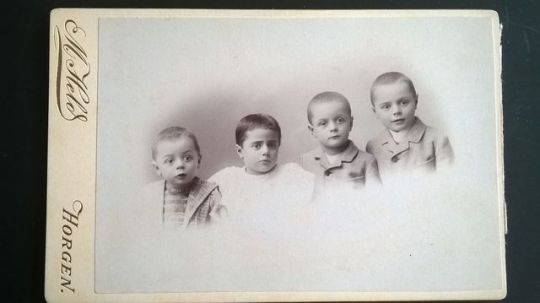
These are the four Tanner children, Paul, Frieda, Arnold (Noldi) and Walter.
Paul, the youngest, emigrated to the United States and settled on the west coast in Portland, Oregon, where there is a large Swiss community. He married Stella (nee: unknown) and had a daughter Fritzi, who settled in Chicago, Illinois.
Frieda, was born in Winterthur, Canton Zurich, Switzerland on September 14th, 1892. She married Alfred Lüthy (Lüthi), on October 22nd, 1920 and had a son, Alfred Luthy, Junior, born May 29th, 1925.
Next is Arnold “Noldi,” who remained in Switzerland and married Sissy (nee: unknown) and had two daughters, Ruth and Irene.
Finally, the eldest is Walter, who also emigrated to the United States and eventually settled in San Clemente, California.
0 notes